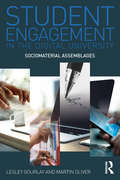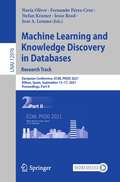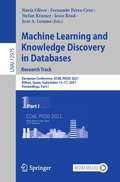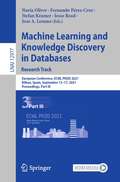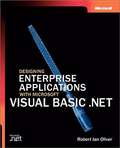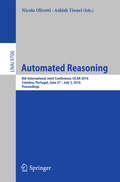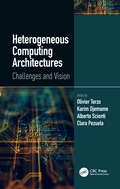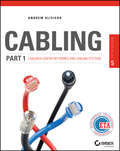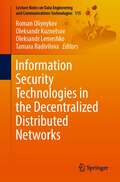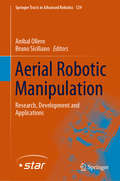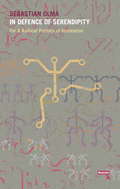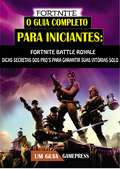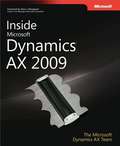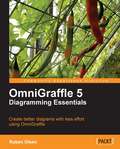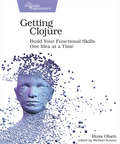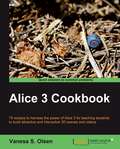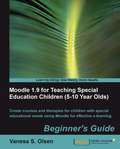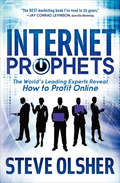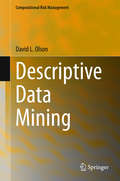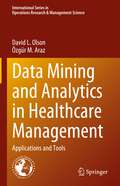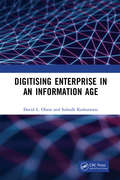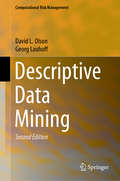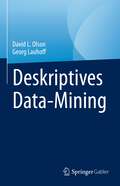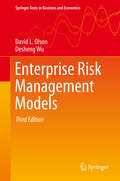- Table View
- List View
Student Engagement in the Digital University: Sociomaterial Assemblages
by Martin Oliver Lesley GourlayStudent Engagement in the Digital University challenges mainstream conceptions and assumptions about students’ engagement with digital resources in Higher Education. While engagement in online learning environments is often reduced to sets of transferable skills or typological categories, the authors propose that these experiences must be understood as embodied, socially situated, and taking place in complex networks of human and nonhuman actors. Using empirical data from a JISC-funded project on digital literacies, this book performs a sociomaterial analysis of student–technology interactions, complicating the optimistic and utopian narratives surrounding technology and education today and positing far-reaching implications for research, policy and practice.
Machine Learning and Knowledge Discovery in Databases. Research Track: European Conference, ECML PKDD 2021, Bilbao, Spain, September 13–17, 2021, Proceedings, Part II (Lecture Notes in Computer Science #12976)
by Nuria Oliver Fernando Pérez-Cruz Stefan Kramer Jesse Read Jose A. LozanoThe multi-volume set LNAI 12975 until 12979 constitutes the refereed proceedings of the European Conference on Machine Learning and Knowledge Discovery in Databases, ECML PKDD 2021, which was held during September 13-17, 2021. The conference was originally planned to take place in Bilbao, Spain, but changed to an online event due to the COVID-19 pandemic. The 210 full papers presented in these proceedings were carefully reviewed and selected from a total of 869 submissions. The volumes are organized in topical sections as follows: Research Track: Part I: Online learning; reinforcement learning; time series, streams, and sequence models; transfer and multi-task learning; semi-supervised and few-shot learning; learning algorithms and applications. Part II: Generative models; algorithms and learning theory; graphs and networks; interpretation, explainability, transparency, safety. Part III: Generative models; search and optimization; supervised learning; text mining and natural language processing; image processing, computer vision and visual analytics. Applied Data Science Track: Part IV: Anomaly detection and malware; spatio-temporal data; e-commerce and finance; healthcare and medical applications (including Covid); mobility and transportation. Part V: Automating machine learning, optimization, and feature engineering; machine learning based simulations and knowledge discovery; recommender systems and behavior modeling; natural language processing; remote sensing, image and video processing; social media.
Machine Learning and Knowledge Discovery in Databases. Research Track: European Conference, ECML PKDD 2021, Bilbao, Spain, September 13–17, 2021, Proceedings, Part I (Lecture Notes in Computer Science #12975)
by Nuria Oliver Fernando Pérez-Cruz Stefan Kramer Jesse Read Jose A. LozanoThe multi-volume set LNAI 12975 until 12979 constitutes the refereed proceedings of the European Conference on Machine Learning and Knowledge Discovery in Databases, ECML PKDD 2021, which was held during September 13-17, 2021. The conference was originally planned to take place in Bilbao, Spain, but changed to an online event due to the COVID-19 pandemic. The 210 full papers presented in these proceedings were carefully reviewed and selected from a total of 869 submissions. The volumes are organized in topical sections as follows: Research Track: Part I: Online learning; reinforcement learning; time series, streams, and sequence models; transfer and multi-task learning; semi-supervised and few-shot learning; learning algorithms and applications. Part II: Generative models; algorithms and learning theory; graphs and networks; interpretation, explainability, transparency, safety. Part III: Generative models; search and optimization; supervised learning; text mining and natural language processing; image processing, computer vision and visual analytics. Applied Data Science Track: Part IV: Anomaly detection and malware; spatio-temporal data; e-commerce and finance; healthcare and medical applications (including Covid); mobility and transportation. Part V: Automating machine learning, optimization, and feature engineering; machine learning based simulations and knowledge discovery; recommender systems and behavior modeling; natural language processing; remote sensing, image and video processing; social media.
Machine Learning and Knowledge Discovery in Databases. Research Track: European Conference, ECML PKDD 2021, Bilbao, Spain, September 13–17, 2021, Proceedings, Part III (Lecture Notes in Computer Science #12977)
by Nuria Oliver Fernando Pérez-Cruz Stefan Kramer Jesse Read Jose A. LozanoThe multi-volume set LNAI 12975 until 12979 constitutes the refereed proceedings of the European Conference on Machine Learning and Knowledge Discovery in Databases, ECML PKDD 2021, which was held during September 13-17, 2021. The conference was originally planned to take place in Bilbao, Spain, but changed to an online event due to the COVID-19 pandemic. The 210 full papers presented in these proceedings were carefully reviewed and selected from a total of 869 submissions. The volumes are organized in topical sections as follows: Research Track: Part I: Online learning; reinforcement learning; time series, streams, and sequence models; transfer and multi-task learning; semi-supervised and few-shot learning; learning algorithms and applications. Part II: Generative models; algorithms and learning theory; graphs and networks; interpretation, explainability, transparency, safety. Part III: Generative models; search and optimization; supervised learning; text mining and natural language processing; image processing, computer vision and visual analytics. Applied Data Science Track: Part IV: Anomaly detection and malware; spatio-temporal data; e-commerce and finance; healthcare and medical applications (including Covid); mobility and transportation. Part V: Automating machine learning, optimization, and feature engineering; machine learning based simulations and knowledge discovery; recommender systems and behavior modeling; natural language processing; remote sensing, image and video processing; social media.
Designing Enterprise Applications with Microsoft® Visual Basic® .NET
by Robert Ian OliverWhile many books cover specific technical issues, they very rarely provide architectural guidance, which is especially helpful with adoption of Microsoft .NET. This title educates developers on just these topics. The expert authors--two members of the Microsoft Visual Basic .NET product team--present technologies within the context of their most appropriate use, and discuss design tradeoffs for large-scale applications. They also offer advanced techniques for performance tuning, testing, and implementation. Architectural Guidance - Delivers the advanced guidance about architecture and tradeoffs that veteran developers need, especially since .NET allows developers to choose and use far more tools and technologies Applied focus - Discusses advanced technologies and real-world consequences of design decisions in conjunction with pervasive issues such as application performance, scalability, and security Expert Authors - Written by two Microsoft Visual Basic team members who are uniquely qualified to show how best to use Visual Basic .NET in developing enterprise applications
The Office: Procedures and Technology
by Mary Ellen Oliverio William R. Pasewark Bonnie R. WhiteTHE OFFICE is a comprehensive text for courses in the high school office technology curriculum. The course name can be Office Procedures, Administrative Procedures, Business and Computer Technology, etc. The target market is high school student preparing for entry-level position in an office setting. The text focuses on the necessary skills that range from using email and the Internet to the use of integrated application and office suites. It covers the soft skills including customer satisfaction ethics, and telephone manners along with information systems and the global marketplace.
Automated Reasoning: 8th International Joint Conference, IJCAR 2016, Coimbra, Portugal, June 27 – July 2, 2016, Proceedings (Lecture Notes in Computer Science #9706)
by Nicola Olivetti Ashish TiwariThis book constitutes the refereed proceedings of the 8th International Joint Conference on Automated Reasoning, IJCAR 2016, held in Coimbra, Portugal, in June/July 2016. IJCAR 2014 was a merger of three leading events in automated reasoning, namely CADE (International Conference on Automated Deduction), FroCoS (International Symposium on Frontiers of Combining Systems) and TABLEAUX (International Conference on Automated Reasoning with Analytic Tableaux and Related Methods). The 26 revised full research papers and 9 system descriptions presented together with 4 invited talks were carefully reviewed and selected from 79 submissions. The papers have been organized in topical sections on satisfiability of Boolean formulas, satisfiability modulo theory, rewriting, arithmetic reasoning and mechanizing mathematics, first-order logic and proof theory, first-order theorem proving, higher-order theorem proving, modal and temporal logics, non-classical logics, and verification.
Heterogeneous Computing Architectures: Challenges and Vision
by Olivier Terzo, Karim Djemame, Alberto Scionti and Clara PezuelaHeterogeneous Computing Architectures: Challenges and Vision provides an updated vision of the state-of-the-art of heterogeneous computing systems, covering all the aspects related to their design: from the architecture and programming models to hardware/software integration and orchestration to real-time and security requirements. The transitions from multicore processors, GPU computing, and Cloud computing are not separate trends, but aspects of a single trend-mainstream; computers from desktop to smartphones are being permanently transformed into heterogeneous supercomputer clusters. The reader will get an organic perspective of modern heterogeneous systems and their future evolution.
Cabling Part 1
by Andrew OlivieroWith the growing demand for fiber optics in large-scale communications networks, network professionals need complete, up-to-the-minute information. This book constitutes Part 1 of Cabling: The Complete Guide to Copper and Fiber-Optic Networking and focuses on LAN Networks and Cabling Systems, offering comprehensive coverage on current cabling methodologies and is updated to the latest industry standards. Contents include:1. Introduction to Data Cabling.2. Cabling Specifications and Standards.3. Choosing the Correct Cabling.4. Cable System and Infrastructure Constraints.5. Cabling System Components.6. Tools of the Trade.7. Copper Cable Media.8. Fiber-Optic Media.9. Wall Plates.10. Connectors.11. Transmission Equipment.12. Ubounded (Wireless) Media.13. Cabling-System Design and Installation.14. Cable-Connector Installation.15. Cable-System Testing and Troubleshooting.16. Creating a Request for Proposal.17. Cabling @ Work: Experience from the Field.
Information Security Technologies in the Decentralized Distributed Networks (Lecture Notes on Data Engineering and Communications Technologies #115)
by Roman Oliynykov Oleksandr Kuznetsov Oleksandr Lemeshko Tamara RadivilovaThe authors explore various aspects of information processing for the design of service systems, efficient management, secure storage, and transmission. In addition, the subline provides knowledge and practice in decentralized ICT technologies, including those based on blockchain. The aim of this book is to analyze and develop methods of building decentralized private databases without the presence of a trusted party, methods of data processing in encrypted form to ensure the confidentiality of information, and accessibility of the corresponding fragment of the original or transformed data. In this book it is also relevant to research methods and protocols routing in infocommunication networks, which provides load balancing in the network, and analysis of intrusion detection methods based on analysis of signatures and anomalies in network behavior (state changes) based on machine learning and fractal analysis methods.
Aerial Robotic Manipulation: Research, Development and Applications (Springer Tracts in Advanced Robotics #129)
by Anibal Ollero Bruno SicilianoAerial robotic manipulation integrates concepts and technologies coming from unmanned aerial systems and robotics manipulation. It includes not only kinematic, dynamics, aerodynamics and control but also perception, planning, design aspects, mechatronics and cooperation between several aerial robotics manipulators. All these topics are considered in this book in which the main research and development approaches in aerial robotic manipulation are presented, including the description of relevant systems. In addition of the research aspects, the book also includes the deployment of real systems both indoors and outdoors, which is a relevant characteristic of the book because most results of aerial robotic manipulation have been validated only indoor using motion tracking systems. Moreover, the book presents two relevant applications: structure assembly and inspection and maintenance, which has started to be applied in the industry. The Chapters of the book will present results of two main European Robotics Projects in aerial robotics manipulation: FP7 ARCAS and H2020 AEROARMS. FP7 ARCAS defined the basic concepts on aerial robotic manipulation, including cooperative manipulation. The H2020 AEROARMS on aerial robot with multiple arms and advanced manipulation capabilities for inspection and maintenance has two general objectives: (1) development of advanced aerial robotic manipulation methods and technologies, including manipulation with dual arms and multi-directional thrusters aerial platforms; and (2) application to the inspection and maintenance.
In Defence of Serendipity
by Seb OlmaIn Defence of Serendipity is a lively and buccaneering work of investigative philosophy, treating the origins of "serendipity, accident and sagacity", both as riddles and philosophical concepts that can be put to a future political use. Taking in Aristotle, LSD, Tony Blair and techno-mysticism, Olma challenges the prevailing faith in the benevolence of digital technology and the illegitimate equation of innovation and entrepreneurship, arguing instead that we must take responsibility for the care of society's digital infrastructure, and prevent its degeneration into an apparatus of marketing and finance. For although there is nothing wrong with marketing and finance per se, if they alone lead technological development, free of any discretionary political interference, the freedom to be exploited will be as much a part of the future as our ability to intervene freely in our lives, will be a thing of the past.
Fortnite - O Guia Completo Para Iniciantes (1 #1)
by Samson Oloruntobi André Luiz Franco de Souza FilhoAprenda as melhores dicas secretas que nunca lhe contaram que vão ajudar você a ganhar todas às vezes no Fortnite Battle Royale. Fortnite está lentamente tomando o mundo, e o jogo se torna mais difícil de ganhar à medida que as temporadas passam. Dicas de alguns meses atrás não são mais úteis porque o Meta mudou para novas táticas. Você vai encontrar melhores inimigos, especialmente se você estiver jogando em uma área com bastantes jogadores. Esse guia, que é o mais completo, é recheado de segredos que você nunca escutou acerca do Fortnite. Você vai aprender todas as dicas e truques que farão de você um profissional no jogo. Essas dicas vão ajudar você a conseguir várias vitórias e ainda vai poder mostrar todas as suas novas habilidades para os seus amigos. Se você joga Fortnite há um tempo e acha que não é bom o suficiente para ganhar, então esse livro é para você. Ele vai fazer você melhorar em todos os sentidos e você vai facilmente conseguir sua primeira vitória, se você ainda não tem. Aqui, nós temos mais de 100 dicas que são perfeitas para iniciantes e jogadores intermediários, e esperamos, para os Profissionais do Fortnite Battle Royale também. E se você acha que sabe tudo de Fortnite, o que você provavelmente sabe mesmo, esse guia vai te dar algo que você não sabe.
Inside Microsoft Dynamics® AX 2009
by Lars Dragheim Olsen Michael Fruergaard Pontoppidan Hans Jorgen Skovgaard Deepak Kumar Satish Thomas Tom KaminskiDig into the architecture and internals of Microsoft Dynamics AX--with firsthand insights from the team who designed and developed it. Deepen your knowledge of the underlying frameworks, components, and tools--and get best-practice guidance to customize and extend your own high-performance solutions. Discover how to: Work with MorphX application-modeling tools and X++ code Exploit built-in workflow infrastructure to simplify process automation Use Enterprise Portal and ASP.NET to build rich, role-based Web portals See how reporting components work together for better business intelligence Execute complex batch jobs with greater control and reliability Learn how the runtime implements configuration and security Walk through integration scenarios and technologies Create and expose services to external applications Optimize application performance and extensibility
OmniGraffle 5 Diagramming Essentials
by Ruben OlsenThis is a very visual book with more than 750 illustrations and screenshots, never leaving any intermediate steps out from the tutorials. It contains precise tutorials that explain the various tools, how to use them, and the visual results. The examples used in the book are an excellent starting point for your own diagrams, both as ideas and as true diagrams - all the diagrams in the book can be downloaded for your own use.This book is written for both beginners and seasoned users of OmniGraffle. If you are new to the software, then this book will teach you everything you need to know to make stunning diagrams. For seasoned OmniGraffle users, this book contains a lot of tricks and techniques that will save their work and time.
Getting Clojure: Build Your Functional Skills One Idea at a Time
by Russ OlsenBehind every programming language lies a vision of how programs should be built. The vision behind Clojure is of a radically simple language framework holding together a sophisticated collection of programming features. Learning Clojure involves much more than just learning the mechanics of the language. To really get Clojure you need to understand the ideas underlying this structure of framework and features. You need this book: an accessible introduction to Clojure that focuses on the ideas behind the language as well as the practical details of writing code. Clojure attracts developers on the cutting edge and is arguably the best language for learning to program in the functional style without compromise. But this comes with a steep learning curve. Getting Clojure directly addresses this by teaching you how to think functionally as it teaches you the language. You'll learn about Clojure's powerful data structures and high-level functions, but you'll also learn what it means for a language to be functional, and how to think in Clojure's functional way.Each chapter of Getting Clojure takes a feature or two or three from the language, explains the syntax and the mechanics behind that feature so that you can make it work before digging into the deeper questions: What is the thinking behind the feature? And how does it fit in with the rest of the language? In Getting Clojure you'll learn Clojure's very simple syntax, but you'll also learn why that syntax is integral the way the language is constructed. You'll discover that most data structures in Clojure are immutable, but also why that leads to more reliable programs. And you'll see how easy it is to write Clojure functions and also how you can use those functions to build complex and capable systems.With real-world examples of how working Clojure programmers use the language, Getting Clojure will help you see the challenges of programming through the eye of experienced Clojure developers.What You Need:You will need to some background in programming. To follow along with the examples in the book, you will need Java 6 or new, Clojure 1.8 or 1.9, and Leiningen 2.
Alice 3 Cookbook
by Vanesa S. OlsenPart of Packt's cookbook series, each chapter focuses on a different aspect of working with Alice. Each recipe has practical, step-by-step instructions with lots of screenshots. This book is designed primarily for teachers developing education plans and willing to exploit 3D environments using Alice 3. Alice users who want to improve their Alice programming skills will also find this book useful as it offers innovative 3D models in action. Some basic knowledge of Alice and how it works is necessary, although you are not expected to have worked with version 3 before.
Moodle 1.9 for Teaching Special Education Children (5-10): Beginner's Guide
by Vanesa S. OlsenWritten with a step-by-step but friendly and engaging approach, this Packt Beginner's Guide is designed to be placed alongside the computer as your guide and mentor. Step-by-step tutorials are boosted by explanations of the reasoning behind what you are doing. You will quickly pick up the necessary skills, tips, and tricks for creating practical exercises using Moodle 1.9 with practical examples and see how the child with special education needs progresses. If you are an SEN teacher or SEN therapist with minimal knowledge of Moodle who is willing to exploit Web 2.0 possibilities using Moodle 1.9 as the background platform, this book is for you.
Internet Prophets: The World's Leading Experts Reveal How to Profit Online
by Steve OlsherMake a fortune online with this powerful, practical, and comprehensive guide to starting a profitable internet business that “couldn’t be more timely” (Jack Canfield, New York Times–bestselling author of Chicken Soup for the Soul). Internet Prophets is arguably the most comprehensive Internet and Mobile marketing resource ever assembled. It features secrets to success from some of the most influential business icons and Internet game-changers. In this industry-defining book by award-winning author Steve Olsher, you’ll discover proven tools, strategies, and shortcuts leveraged by the world’s leading Internet and Mobile marketing experts as well as hundreds of no-to-low-cost tactics for cultivate leads. You will learn how to dramatically increase conversion rates and generate immediate and long-term cash flow. This practical business guide also contains the specific steps you must take to dominate your niche, establish significant brand awareness, and foster a loyal following. To become the best, you must learn from the best. Internet Prophets provides the blueprint. The rest is up to you!
Descriptive Data Mining
by David L. OlsonThis book offers an overview of knowledge management. It starts with an introduction to the subject, placing descriptive models in the context of the overall field as well as within the more specific field of data mining analysis. Chapter 2 covers data visualization, including directions for accessing R open source software (described through Rattle). Both R and Rattle are free to students. Chapter 3 then describes market basket analysis, comparing it with more advanced models, and addresses the concept of lift. Subsequently, Chapter 4 describes smarketing RFM models and compares it with more advanced predictive models. Next, Chapter 5 describes association rules, including the APriori algorithm and provides software support from R. Chapter 6 covers cluster analysis, including software support from R (Rattle), KNIME, and WEKA, all of which are open source. Chapter 7 goes on to describe link analysis, social network metrics, and open source NodeXL software, and demonstrates link analysis application using PolyAnalyst output. Chapter 8 concludes the monograph. Using business-related data to demonstrate models, this descriptive book explains how methods work with some citations, but without detailed references. The data sets and software selected are widely available and can easily be accessed.
Data Mining and Analytics in Healthcare Management: Applications and Tools (International Series in Operations Research & Management Science #341)
by David L. Olson Özgür M. ArazThis book presents data mining methods in the field of healthcare management in a practical way. Healthcare quality and disease prevention are essential in today’s world. Healthcare management faces a number of challenges, e.g. reducing patient growth through disease prevention, stopping or slowing disease progression, and reducing healthcare costs while improving quality of care. The book provides an overview of current healthcare management problems and highlights how analytics and knowledge management have been used to better cope with them. It then demonstrates how to use descriptive and predictive analytics tools to help address these challenges. In closing, it presents applications of software solutions in the context of healthcare management. Given its scope, the book will appeal to a broad readership, from researchers and students in the operations research and management field to practitioners such as data analysts and decision-makers who work in the healthcare sector.
Digitising Enterprise in an Information Age
by David L. Olson Subodh KesharwaniDigitising Enterprise in an Information Age is an effort that focuses on a very vast cluster of Enterprises and their digitising technology involvement and take us through the road map of the implementation process in them, some of them being ICT, Banking, Stock Markets, Textile Industry & ICT, Social Media, Software Quality Assurance, Information Systems Security and Risk Management, Employee Resource Planning etc. It delves on increased instances of cyber spamming and the threat that poses to e-Commerce and Banking and tools that help and Enterprise toward of such threats. To quote Confucius, “As the water shapes itself to the vessel that contains it, so does a wise man adapts himself to circumstances.” And the journey of evolution and progression will continue and institutions and enterprises will continue to become smarter and more and more technology savvy. Enterprises and businesses across all genre and spectrum are trying their level best to adopt to change and move on with the changing requirements of technology and as enterprises and companies upgrade and speed up their digital transformations and move their outdate heirloom systems to the cloud, archaic partners that don't keep up will be left behind. Note: T&F does not sell or distribute the Hardback in India, Pakistan, Nepal, Bhutan, Bangladesh and Sri Lanka.
Descriptive Data Mining (Computational Risk Management)
by David L. Olson Georg LauhoffThis book provides an overview of data mining methods demonstrated by software. Knowledge management involves application of human knowledge (epistemology) with the technological advances of our current society (computer systems) and big data, both in terms of collecting data and in analyzing it. We see three types of analytic tools. Descriptive analytics focus on reports of what has happened. Predictive analytics extend statistical and/or artificial intelligence to provide forecasting capability. It also includes classification modeling. Diagnostic analytics can apply analysis to sensor input to direct control systems automatically. Prescriptive analytics applies quantitative models to optimize systems, or at least to identify improved systems. Data mining includes descriptive and predictive modeling. Operations research includes all three. This book focuses on descriptive analytics.The book seeks to provide simple explanations and demonstration of some descriptive tools. This second edition provides more examples of big data impact, updates the content on visualization, clarifies some points, and expands coverage of association rules and cluster analysis. Chapter 1 gives an overview in the context of knowledge management. Chapter 2 discusses some basic software support to data visualization. Chapter 3 covers fundamentals of market basket analysis, and Chapter 4 provides demonstration of RFM modeling, a basic marketing data mining tool. Chapter 5 demonstrates association rule mining. Chapter 6 is a more in-depth coverage of cluster analysis. Chapter 7 discusses link analysis. Models are demonstrated using business related data. The style of the book is intended to be descriptive, seeking to explain how methods work, with some citations, but without deep scholarly reference. The data sets and software are all selected for widespread availability and access by any reader with computer links.
Deskriptives Data-Mining
by David L. Olson Georg LauhoffDieses Buch bietet einen Überblick über Data-Mining-Methoden, die durch Software veranschaulicht werden. Beim Wissensmanagement geht es um die Anwendung von menschlichem Wissen (Erkenntnistheorie) mit den technologischen Fortschritten unserer heutigen Gesellschaft (Computersysteme) und Big Data, sowohl bei der Datenerfassung als auch bei der Datenanalyse. Es gibt drei Arten von Analyseinstrumenten. Die deskriptive Analyse konzentriert sich auf Berichte über das, was passiert ist. Bei der prädiktiven Analyse werden statistische und/oder künstliche Intelligenz eingesetzt, um Vorhersagen treffen zu können. Dazu gehört auch die Modellierung von Klassifizierungen. Die diagnostische Analytik kann die Analyse von Sensoreingaben anwenden, um Kontrollsysteme automatisch zu steuern. Die präskriptive Analytik wendet quantitative Modelle an, um Systeme zu optimieren oder zumindest verbesserte Systeme zu identifizieren. Data Mining umfasst deskriptive und prädiktive Modellierung. Operations Research umfasst alle drei Bereiche. Dieses Buch konzentriert sich auf die deskriptive Analytik.Das Buch versucht, einfache Erklärungen und Demonstrationen einiger deskriptiver Werkzeuge zu liefern. Es bietet Beispiele für die Auswirkungen von Big Data und erweitert die Abdeckung von Assoziationsregeln und Clusteranalysen. Kapitel 1 gibt einen Überblick im Kontext des Wissensmanagements. Kapitel 2 erörtert einige grundlegende Softwareunterstützung für die Datenvisualisierung. Kapitel 3 befasst sich mit den Grundlagen der Warenkorbanalyse, und Kapitel 4 demonstriert die RFM-Modellierung, ein grundlegendes Marketing-Data-Mining-Tool. Kapitel 5 demonstriert das Assoziationsregel-Mining. Kapitel 6 befasst sich eingehender mit der Clusteranalyse. Kapitel 7 befasst sich mit der Link-Analyse. Die Modelle werden anhand geschäftsbezogener Daten demonstriert. Der Stil des Buches ist beschreibend und versucht zu erklären, wie die Methoden funktionieren, mit einigen Zitaten, aber ohne tiefgehende wissenschaftliche Referenzen. Die Datensätze und die Software wurden so ausgewählt, dass sie für jeden Leser, der über einen Computeranschluss verfügt, weithin verfügbar und zugänglich sind.
Enterprise Risk Management Models (Springer Texts in Business and Economics)
by David L. Olson Desheng WuThis book offers a comprehensive guide to several aspects of risk, including information systems, disaster management, supply chain and disaster management perspectives. A major portion of the book is devoted to presenting a number of operations research models that have been (or could be) applied to enterprise supply risk management, especially from the supply chain perspective. Each chapter of this book can be used as a stand-alone module on a respective topic, with dedicated examples, definitions and discussion notes. This book comes at a time when the world is increasingly challenged by different forms of risk and how to manage them. Events of the 21st Century have made enterprise risk management even more critical. Risks such as suspicions surrounding top-management structures, financial and technology bubbles (especially since 2008), as well as the risk posed by terrorism, such as the 9/11 attacks in the U.S. as well as more recent events in France, Belgium, and other European countries, have a tremendous impact on many facets of business. Businesses, in fact, exist to cope with risk in their area of specialization.
